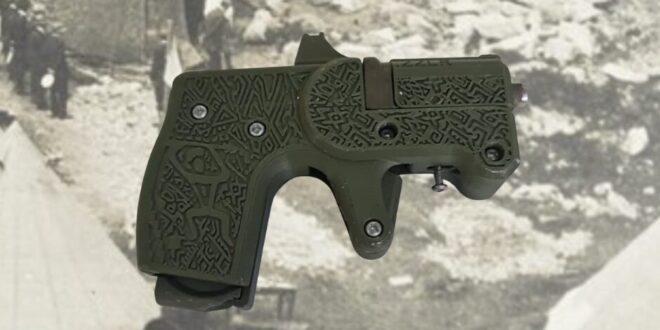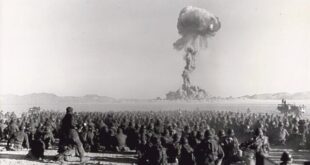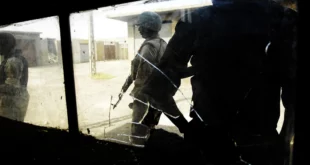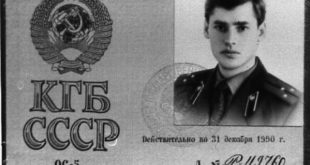by James Parker
Northern Ireland’s paramilitary underworld is learning to fight with the tools of the digital age, and these tools are becoming more sophisticated and accessible.
As a crowd gathered in Belfast to commemorate Ireland’s 1916 Easter Rising, something new made an appearance in the arsenal of Northern Ireland’s paramilitaries. A member of Óglaigh na hÉireann (ÓNH), an insurgent splinter group, stood flanked by two masked figures. On that day in 2022 in Milltown Cemetery, they cradled what appeared to be conventional sub-machine guns. But these weren’t old Provisional Irish Republican Army (PIRA) weapons, or new black-market arrivals. These were 3D-printed firearms.
The weapons were FGC-22’s – a .22 LR variant of the FGC-9, designed by Jacob Duygu, an icon of the homemade firearms movement. His work has been embraced by dissidents, activists, criminals, and rebels worldwide – a global community of underground gunsmiths.
The Evolution of DIY Firepower
The appearance of 3D-printed guns in Northern Ireland isn’t necessarily shocking. The region has a long history of makeshift armaments. In the 1960’s, Loyalist paramilitaries painted water pistols black to intimidate rivals. By the 1990’s, the Ulster Volunteer Force (UVF) was covertly producing “Avenger” sub-machine guns, while Republican factions were churning out makeshift explosives, handheld recoilless rocket launchers, and crude soup can grenades.
But the FGC-9 is not your grandfather’s break-line zip gun. Early 3D-printed weapons, like the single-shot Liberator pistol, were severely limited – fragile, unreliable, and difficult to produce. The FGC-9 changed that. It’s reliable, capable of sustained fire, fed from printed or factory Glock magazines built with commonly available parts, and requires no regulated gun components. The FGC-9 revolutionised what was thought possible for 3D-printed firearms, and greatly lowered the skill required to produce effective homemade firearms.
Paramilitary Stockpiles Depleted
The ÓNH’s adoption of 3D-printed weapons has continued. It comes at a time when acquiring traditional firearms is tougher than ever. The decommissioning of weapons after the Good Friday Agreement, coupled with years of police crackdowns, severely depleted paramilitary stockpiles.
Heavyweights like the New IRA and Continuity IRA retain access to factory-made assault rifles, grenades, and handguns. Smaller factions like ÓNH, however, have had to rely on aged PIRA leftovers, antiques, and converted blank-firing guns. In 2016, an ÓNH show-of-strength ended with just a handful of shots fired from a single worse-for-wear revolver. The shift toward 3D-printed guns is in part a desperate response to dwindling supply lines.
Do These 3d-Printed Guns Change the Game?
From a tactical standpoint, the value of 3D-printed firearms remains questionable. Most designs are chambered in pistol calibres, like 9mm or .22 LR, better suited to shooting rabbits than the modern urban guerilla fighting the British state. Nor is it clear that ÓNH is producing reliable weapons or that members can use them effectively. The FGC-9 used during one tribute misfired, and the FGC-9 featured in September 2024 propaganda photos was missing its magazine – suggesting that, at least for now, they have mostly been brandished, and are not seeing regular use.
But for ÓNH, these guns are as much about symbolism as function. Their mere presence and continued prominence of 3D-printed firearms in ÓNH releases send a clear message to rivals, potential recruits, and UK authorities: We are still here and adapting.
Whatever their limitations, 3D-printed weapons offer distinct advantages for underground groups. They’re disposable, difficult to trace, and don’t require complex smuggling networks. In a developed country like the UK, where strict gun laws and effective law enforcement make traditional acquisition difficult, the ability to manufacture firearms on demand for the ammunition available is a game-changer for these organizations. In Myanmar, rebel groups have used FGC-9’s in hit-and-run attacks to capture factory weapons from government forces. It’s not inconceivable that similar tactics could be employed in Northern Ireland.
The accessibility of firearm blueprints presents a challenge to authorities seeking to manage these groups. Historically, paramilitary leaders tightly controlled their arsenals to prevent police seizures and internal schisms. Now, with blueprints freely accessible online, anyone with the right equipment can become an arms manufacturer.
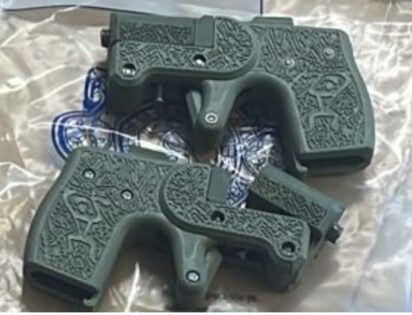
Two 3D-printed guns seized in the Republic of Ireland. Photo: An Garda Síochána
In terms of the Troubles, 3D-printed guns alone can’t reignite the conflict. Paramilitary groups still face major technological and logistical bottlenecks. Even 3D-printed firearms are useless without reliable access to ammunition, which is difficult to reliably home manufacture. And while ÓNH might be embracing polymer-based weapons, current technology means they cannot replicate the RPG-7’s, select-fire intermediate calibre rifles, and heavy machine guns that once defined the conflict.
The Bigger Picture
For now, 3D-printed firearms are a niche tool in Northern Ireland’s paramilitary landscape. But their presence signals a larger shift – one where militants no longer rely on state-supplied arms shipments or clandestine smuggling networks. My sense is, they likely will find their way south, into the Republic of Ireland.
For ÓNH, the reliance on printed firearms tells a story of desperation, adaptability, division, and attention. Whether these weapons become a minor footnote or a significant force multiplier remains to be seen.
Arms may not create conflict, but as Muammar Gaddafi’s various arms shipments to the PIRA showed, they can alter the dynamics of a conflict fundamentally. Whatever the case, this much is clear: Northern Ireland’s paramilitary underworld, like insurgencies worldwide, is learning to fight with the tools of the digital age, and these tools are becoming more sophisticated and accessible.
Editor’s note: I accepted this article for publication after I was contacted by James Parker, a promising young British writer who hoped to forge a career as a journalist covering paramilitary activities. His response when I told him I’d use his story: “That’s brilliant, thanks so much!” It is with great sadness that I report that I heard from his mother, Maxine, that James passed away before he had the chance to see his article published. Not long after I heard the news about James, several 3D printed firearms turned up in the Republic of Ireland – just as James had predicted. A tip of the Red Beret to James, and also to Maxine, for being such a stalwart advocate working to preserve her son’s legacy. ~SKK

(James Parker. Photo: Courtesy, Maxine Parker)
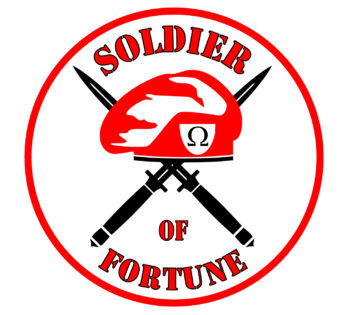
 Soldier of Fortune Magazine The Journal of Professional Adventurers
Soldier of Fortune Magazine The Journal of Professional Adventurers


